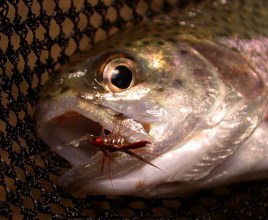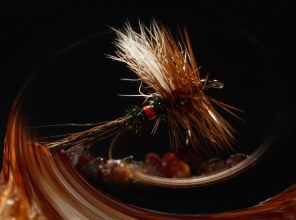Invicta Flies - Protect Your Investment

LONG-LASTING FLIES
 |
Discriminating fly fishers know a well-tied fly. Even most beginners can spot quality in one fly versus another. While many things in flyfishing can cost quite a bit more, the flies are still an investment, not only in the cost of materials, but in your time and your enjoyment on the water as well. Using good materials and tying methods for durable flies can help keep flies in use longer, but other forces can cause the premature demise of even the best-tied fly. Here are few tips and reminders on how to prolong the life of your best flies.
|
LOSS PREVENTION
Sometimes losing flies just can't be prevented. Often fish hang out in places full of rocks, limbs, and brush. But there are some things you can do to better your chances of keeping that fly to cast again.
Use the right tippet size. Always use the largest size possible, downsizing only if the line seems to be putting the fish off, or as conditions require. Typically, you can divide the size of the fly by three to get the best suited tippet size. (ex. size 18 fly ¸ 3 = 6x tippet)
Use the right equipment. Trying to cast a fly too large for the size of rod/line you're using can cause poor casting, which in turn inhibits accuracy, produces "wind knots" that weaken the leader and tippet, or makes the fly hit the rod tip. You should be able to comfortably cast the fly without much effort. If you are unsure of the size, ask for advice from others. With the right size of equipment, hone your casting skills continually (always a good practice).
Take your time. Don't rush the cast. Let nature's rhythm be your guide. Additionally, a quick, hurried knot is a weak knot. Most tippet material stretches a bit to absorb some of the shock of a fighting fish. In forming a knot, it also heats up from the friction, causing weak spots. Always wet the knot well before pulling tight, and then pull with an even pressure, allowing a moment for the stretch to work itself through the knot. A sharp tug causes the weakening friction heat. Pay attention to your knot and make sure everything is seated right. It's a good idea to practice tying knots at home in different sizes of tippet material. This will get you familiar with the knots and ensure a sound connection while on the water.
Check your tippet often. Rocks, logs, teeth, and many other things can put nicks and tears in the tippet. Run a finger over the tippet to check it's smoothness, paying particular attention to the portion nearest the fly. If you feel any rough spots, replace the tippet. What may seem like an insignificant spot of wear may mean the difference between landing that trophy or donating your fly to the cause. Make sure you're using fresh materials... tippet material will break down year to year and weaken.
|
 |
STORAGE
How you keep your flies when they are not in use can have a big impact on how long they last and how well they perform the next time they're used.
Select the best box. There is vast array of flyboxes on the market. Choose one that securely holds the flies yet allows for easy removal. Different styles of flies may call for different storing. In general, a good container will hold the fly so its materials can lie naturally. Over-filling a box so that each fly is pushing the hackles or wings of the next will cause the materials to "set" in that position. Allow ample room. A streamer wallet is a good way to carry those types of flies, but again, do not overfill, and when closing, stroke the wings to lie flat, lining up somewhat with the hook. Streamers where a full, rounded hackle collar is essential to the pattern should not go in these, as the collar would get flattened and therefore need to be straightened before fishing. Compartment boxes are great, but the flies placed in them also need to be kept to a minimum to prevent bending of the materials. If you like foam insert boxes, pay particular attention to the dry flies. Try not to bend the tails or hackle too much, and use a pencil or other object to pull the hackles on the bottom forward. If bending the hackles cannot be prevented, use the pencil to form a "V" shape underneath, with the fibers leaning out to the sides. They will end up set in this position, but it is the least detrimental to the fly's effectiveness.
Dry the fly well. Most flyboxes do not allow for adequate ventilation to dry your fly. Water trapped in the fly or absorbed by the foam will cause hooks to rust and natural materials to deteriorate quickly. Use your fly patch while on the water. If possible, leave flies out or keep the box open on the ride home. If this is not feasible, at the first opportunity (as soon as you get home), open up the box and let it air out for a day or so in a safe place. Flies that are waterlogged, such as streamers or bass bugs, should be removed and placed on a paper towel to dry, out of the way of kids or pets.
STRAIGHTEN OUT THE FLY.
Before you leave your flies to dry on their own, straighten out the wings, hackles, and tails. Remember that they will generally set in whatever position they were when wet. On some flies this won't affect it's use, but on most it will. This will also prevent microscopic weak spots from forming in natural materials (which would cause feathers or hair to break with minimum effort).
SUMMARY
 |